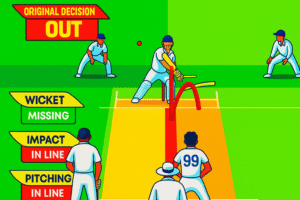Introduction
Cricket is one of the most popular sports in the world, known for its excitement and unpredictable nature. However, umpiring errors have often led to controversial moments that can change the outcome of matches. To ensure fair play and accurate decisions, the Decision Review System (DRS) was introduced. DRS uses advanced technology to help umpires make correct calls, reducing human errors and improving the quality of the game.
DRS Full form in cricket
The full form of DRS in cricket is Decision Review System. It is a technology-driven system used to assist umpires in making better decisions. It allows players to challenge an umpire’s decision and have it reviewed by the third umpire using various technological tools

Types of DRS in cricket
There are two main types of DRS reviews used in cricket:
- Player Review: Players from the batting or bowling side can challenge an on-field umpire’s decision. The team captain or the involved batsman/bowler can request a review.
- Umpire Review: If the on-field umpire is uncertain about a decision, they can refer it to the third umpire for further review.
Components of DRS
DRS relies on several advanced technologies to ensure accurate decision-making:
- Hawk-Eye: This ball-tracking system predicts the ball’s path and determines whether it would hit the stumps. It is mostly used for LBW (Leg Before Wicket) decisions.
- UltraEdge/Snickometer: This tool detects small edges by analyzing sound and visual spikes when the ball touches the bat or pad.
- Ball-Tracking Technology: This technology predicts the trajectory of the ball after hitting the batsman’s pad to assist in LBW decisions.
- Hotspot: Infrared cameras detect heat generated when the ball contacts the bat, pad, or gloves. This helps identify faint edges.
- Slow-Motion Replays: High-speed cameras capture close moments, such as run-outs and stumpings, for better accuracy.
How DRS Works
The process of using DRS in cricket involves the following steps:
A player requests a review within 15 seconds of the on-field umpire’s decision.
The third umpire examines multiple camera angles and uses technologies like UltraEdge, Hawk-Eye, and Hotspot to analyze the decision.
If the evidence proves that the on-field umpire made an incorrect decision, the decision is reversed. If there is no conclusive proof, the original decision stands (Umpire’s Call).
How Many DRS Allowed in Test ,ODI and T20 cricket
The number of DRS reviews allowed depends on the format of the game:
- Test Cricket: Each team gets three unsuccessful reviews per innings.
- One-Day Internationals (ODIs): Each team gets two unsuccessful reviews per innings.
- T20 Internationals (T20Is): Each team gets one unsuccessful review per innings.
A team does not lose a review if the decision is overturned in their favor.
How Long Has DRS Been in Cricket
The Decision Review System was first introduced in 2008 during a Test series between India and Sri Lanka. After testing and improvements, it became an official part of Test cricket in 2009, ODIs in 2011, and T20Is in 2017. Over the years, DRS has evolved with better technology and has become an integral part of modern cricket.
Advantages of DRS in Cricket
The introduction of DRS has significantly benefited the game. Here are some key advantages:
- Reduces Umpiring Errors: DRS helps correct wrong decisions, ensuring more accuracy in umpiring.
- Ensures Fair Play: Teams can challenge incorrect decisions, leading to more fairness in the game.
- Increases Viewer Engagement: Fans enjoy watching advanced technology in action, making the game more exciting.
- Boosts Players’ Confidence: Players feel assured knowing that technology can correct human errors.
- Promotes Transparency: With visible evidence, umpiring decisions are more credible and transparent.
- Improves Match Standards: With fewer errors, cricket becomes more professional and reliable.
First Batsman Out by DRS in Cricket
The first batsman to be dismissed using DRS was Tillakaratne Dilshan of Sri Lanka in 2008 during a Test match against India. He was given out LBW after the Indian team successfully reviewed the on-field umpire’s decision.
DRS System in Cricket Cost
The cost of implementing DRS in a cricket match varies depending on the level of technology used. On average, it can range from $60,000 to $100,000 per match. The high cost is due to the sophisticated ball-tracking, infrared cameras, and other advanced technologies required for accurate decision-making. Due to these costs, DRS is mainly used in international cricket and high-profile leagues.
Conclusion
The Decision Review System (DRS) has revolutionized cricket by making umpiring decisions more accurate and fair. It has significantly reduced human errors and improved the credibility of the game. DRS is expected to become even more efficient in the future. This system has transformed cricket, making it a more transparent and enjoyable sport for players and fans alike.
By embracing technology, cricket has taken a major step toward fairness and accuracy, ensuring that every decision is made with the highest level of precision.










One Comment
Dicta minus neque alias facere Dolorum molestiae sequi ea. eveniet ab qui veniam est illum. saepe voluptas reprehenderit.